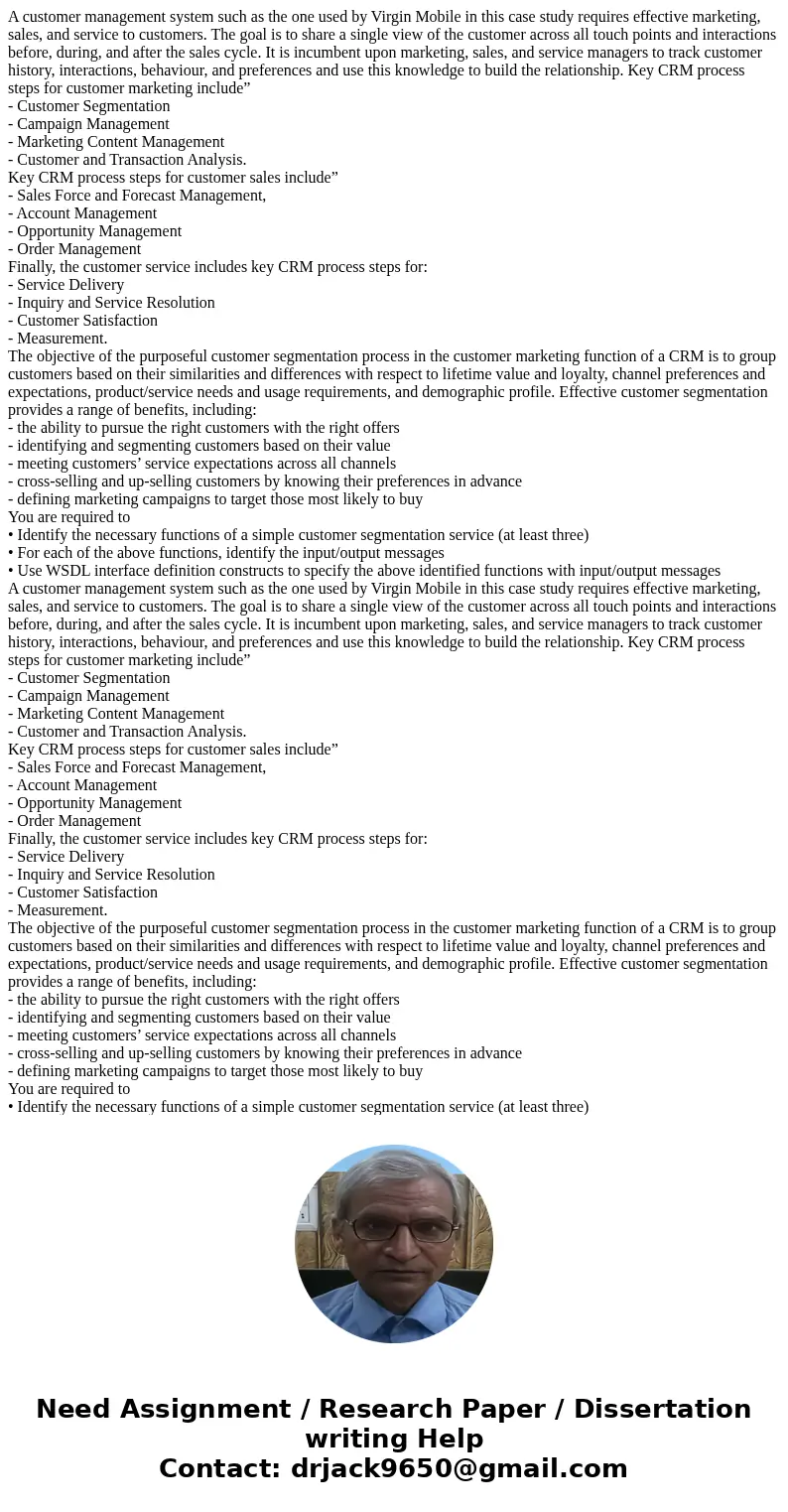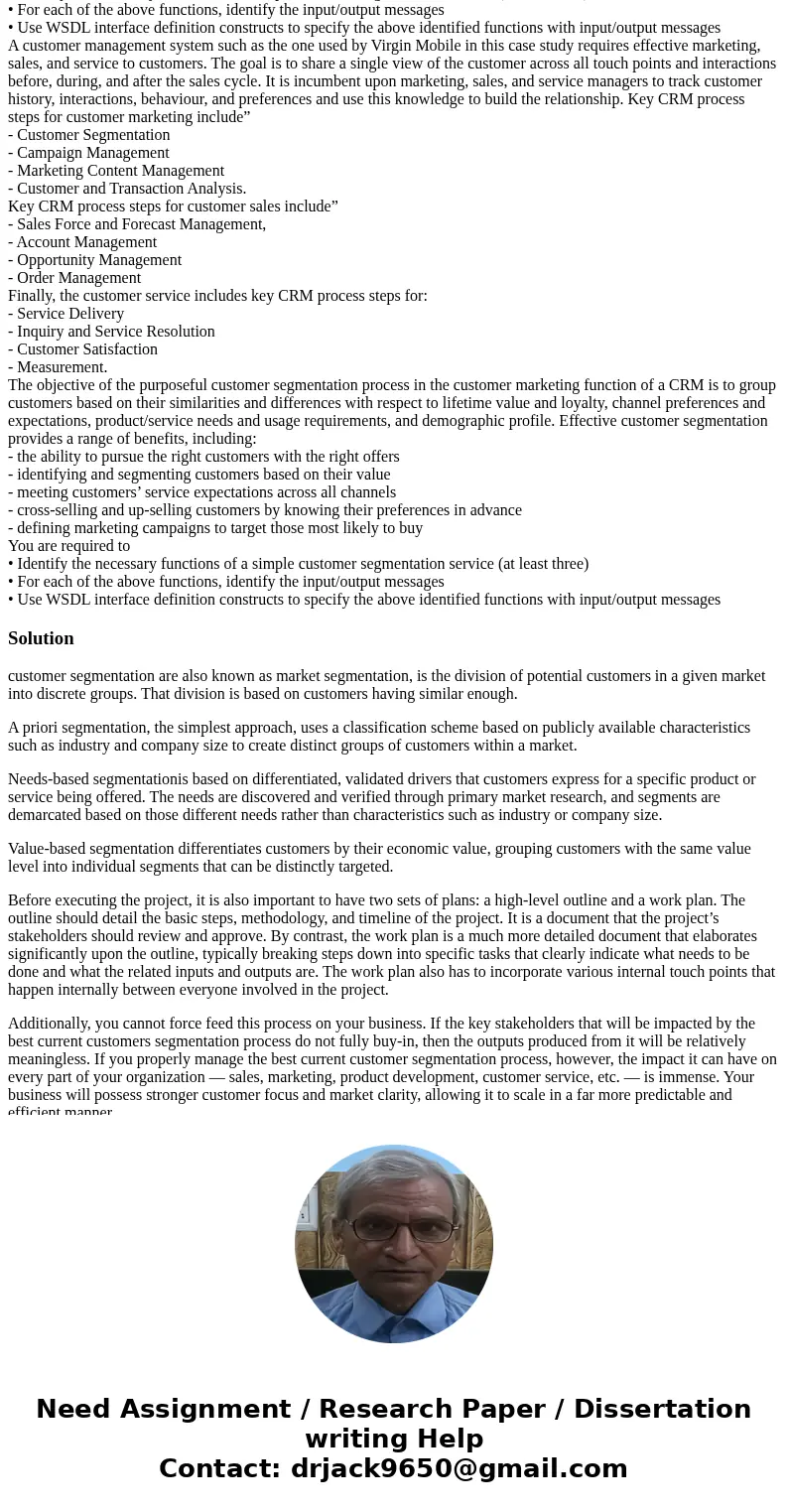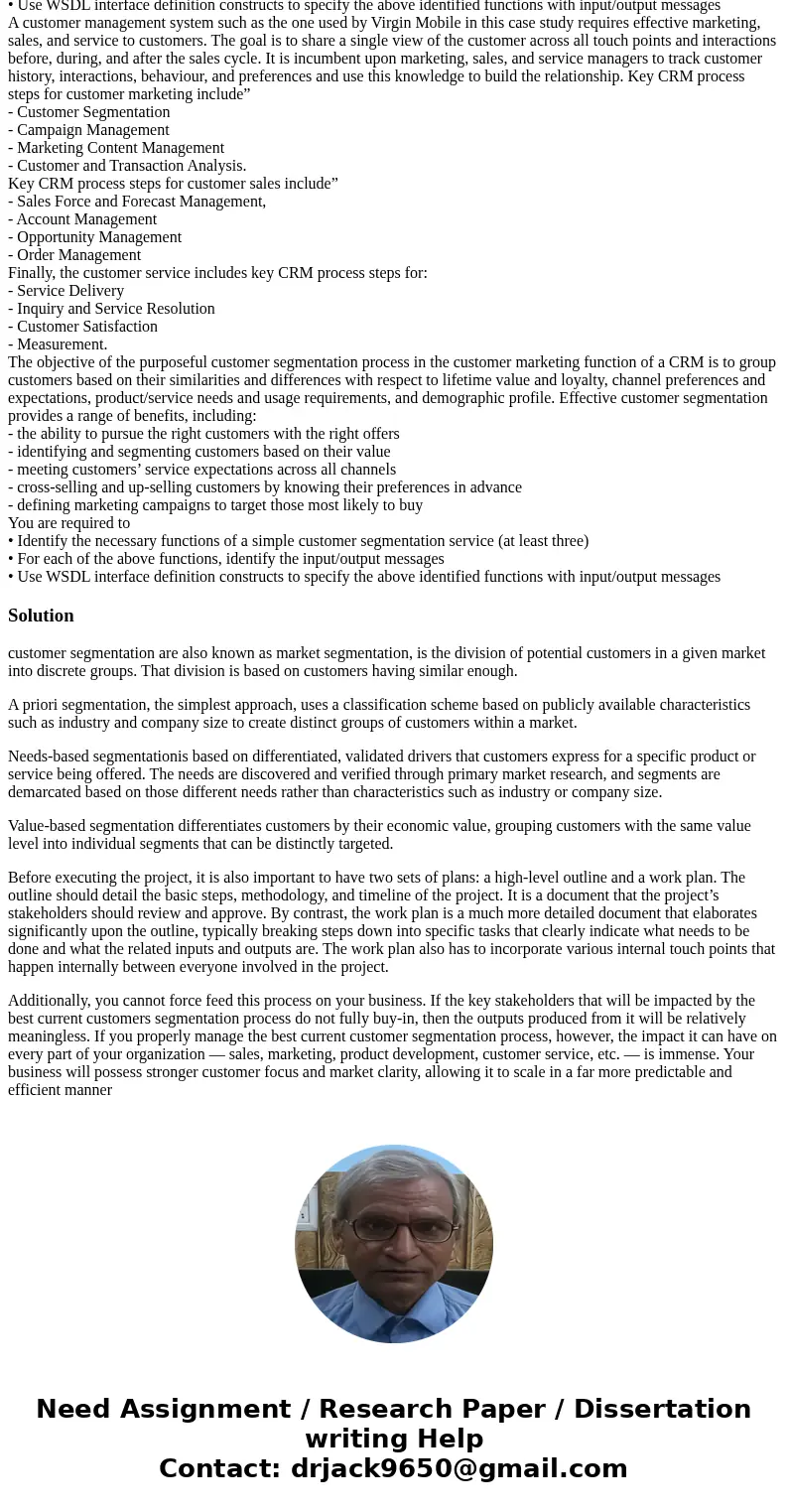A customer management system such as the one used by Virgin Mobile in this case study requires effective marketing, sales, and service to customers. The goal is to share a single view of the customer across all touch points and interactions before, during, and after the sales cycle. It is incumbent upon marketing, sales, and service managers to track customer history, interactions, behaviour, and preferences and use this knowledge to build the relationship. Key CRM process steps for customer marketing include”
- Customer Segmentation
- Campaign Management
- Marketing Content Management
- Customer and Transaction Analysis.
Key CRM process steps for customer sales include”
- Sales Force and Forecast Management,
- Account Management
- Opportunity Management
- Order Management
Finally, the customer service includes key CRM process steps for:
- Service Delivery
- Inquiry and Service Resolution
- Customer Satisfaction
- Measurement.
The objective of the purposeful customer segmentation process in the customer marketing function of a CRM is to group customers based on their similarities and differences with respect to lifetime value and loyalty, channel preferences and expectations, product/service needs and usage requirements, and demographic profile. Effective customer segmentation provides a range of benefits, including:
- the ability to pursue the right customers with the right offers
- identifying and segmenting customers based on their value
- meeting customers’ service expectations across all channels
- cross-selling and up-selling customers by knowing their preferences in advance
- defining marketing campaigns to target those most likely to buy
You are required to
• Identify the necessary functions of a simple customer segmentation service (at least three)
• For each of the above functions, identify the input/output messages
• Use WSDL interface definition constructs to specify the above identified functions with input/output messages
A customer management system such as the one used by Virgin Mobile in this case study requires effective marketing, sales, and service to customers. The goal is to share a single view of the customer across all touch points and interactions before, during, and after the sales cycle. It is incumbent upon marketing, sales, and service managers to track customer history, interactions, behaviour, and preferences and use this knowledge to build the relationship. Key CRM process steps for customer marketing include”
- Customer Segmentation
- Campaign Management
- Marketing Content Management
- Customer and Transaction Analysis.
Key CRM process steps for customer sales include”
- Sales Force and Forecast Management,
- Account Management
- Opportunity Management
- Order Management
Finally, the customer service includes key CRM process steps for:
- Service Delivery
- Inquiry and Service Resolution
- Customer Satisfaction
- Measurement.
The objective of the purposeful customer segmentation process in the customer marketing function of a CRM is to group customers based on their similarities and differences with respect to lifetime value and loyalty, channel preferences and expectations, product/service needs and usage requirements, and demographic profile. Effective customer segmentation provides a range of benefits, including:
- the ability to pursue the right customers with the right offers
- identifying and segmenting customers based on their value
- meeting customers’ service expectations across all channels
- cross-selling and up-selling customers by knowing their preferences in advance
- defining marketing campaigns to target those most likely to buy
You are required to
• Identify the necessary functions of a simple customer segmentation service (at least three)
• For each of the above functions, identify the input/output messages
• Use WSDL interface definition constructs to specify the above identified functions with input/output messages
A customer management system such as the one used by Virgin Mobile in this case study requires effective marketing, sales, and service to customers. The goal is to share a single view of the customer across all touch points and interactions before, during, and after the sales cycle. It is incumbent upon marketing, sales, and service managers to track customer history, interactions, behaviour, and preferences and use this knowledge to build the relationship. Key CRM process steps for customer marketing include”
- Customer Segmentation
- Campaign Management
- Marketing Content Management
- Customer and Transaction Analysis.
Key CRM process steps for customer sales include”
- Sales Force and Forecast Management,
- Account Management
- Opportunity Management
- Order Management
Finally, the customer service includes key CRM process steps for:
- Service Delivery
- Inquiry and Service Resolution
- Customer Satisfaction
- Measurement.
The objective of the purposeful customer segmentation process in the customer marketing function of a CRM is to group customers based on their similarities and differences with respect to lifetime value and loyalty, channel preferences and expectations, product/service needs and usage requirements, and demographic profile. Effective customer segmentation provides a range of benefits, including:
- the ability to pursue the right customers with the right offers
- identifying and segmenting customers based on their value
- meeting customers’ service expectations across all channels
- cross-selling and up-selling customers by knowing their preferences in advance
- defining marketing campaigns to target those most likely to buy
You are required to
• Identify the necessary functions of a simple customer segmentation service (at least three)
• For each of the above functions, identify the input/output messages
• Use WSDL interface definition constructs to specify the above identified functions with input/output messages
customer segmentation are also known as market segmentation, is the division of potential customers in a given market into discrete groups. That division is based on customers having similar enough.
A priori segmentation, the simplest approach, uses a classification scheme based on publicly available characteristics such as industry and company size to create distinct groups of customers within a market.
Needs-based segmentationis based on differentiated, validated drivers that customers express for a specific product or service being offered. The needs are discovered and verified through primary market research, and segments are demarcated based on those different needs rather than characteristics such as industry or company size.
Value-based segmentation differentiates customers by their economic value, grouping customers with the same value level into individual segments that can be distinctly targeted.
Before executing the project, it is also important to have two sets of plans: a high-level outline and a work plan. The outline should detail the basic steps, methodology, and timeline of the project. It is a document that the project’s stakeholders should review and approve. By contrast, the work plan is a much more detailed document that elaborates significantly upon the outline, typically breaking steps down into specific tasks that clearly indicate what needs to be done and what the related inputs and outputs are. The work plan also has to incorporate various internal touch points that happen internally between everyone involved in the project.
Additionally, you cannot force feed this process on your business. If the key stakeholders that will be impacted by the best current customers segmentation process do not fully buy-in, then the outputs produced from it will be relatively meaningless. If you properly manage the best current customer segmentation process, however, the impact it can have on every part of your organization — sales, marketing, product development, customer service, etc. — is immense. Your business will possess stronger customer focus and market clarity, allowing it to scale in a far more predictable and efficient manner



 Homework Sourse
Homework Sourse